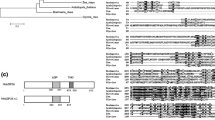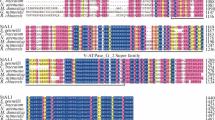Abstract
Plant-specific BURP family proteins have a diverse subcellular localization with different functions. However, only limited studies have investigated the functions of their different domains. In the present study, the role of the N-terminal putative signal peptide in protein subcellular localization was investigated using a tobacco cell system. The results showed that SALI3-2 was present in vacuoles, whereas AtRD22 was directed to the apoplast. The N-terminal putative signal peptides of both proteins were confirmed to be the essential and critical domains for targeting the proteins to their destinations. We also demonstrate that the expression and accumulation of mGFP in tobacco cells was increased when mGFP was fused to the putative signal peptide of SALI3-2. The findings offer the potential application of this short peptide in protein production in plants.





Similar content being viewed by others
References
Ailor E, Betenbaugh MJ (1998) Overexpression of a cytosolic chaperone to improve solubility and secretion of a recombinant IgG protein in insect cells. Biotechnol Bioeng 58:196–203
Alken M, Rutz C, Kochl R, Donalies U, Oueslati M, Furkert J, Wietfeld D, Hermosilla R, Scholz A, Beyermann M, Rosenthal W, Schulein R (2005) The signal peptide of the rat corticotropin-releasing factor receptor 1 promotes receptor expression but is not essential for establishing a functional receptor. Biochem J 390:455–464
Batchelor AK, Boutilier K, Miller SS, Hattori J, Bowman LA, Hu M, Lantin S, Johnson DA, Miki BL (2002) SCB1, a BURP-domain protein gene, from developing soybean seed coats. Planta 215:523–532
Daniell H, Streatfield SJ, Wycoff K (2001) Medical molecular farming: production of antibodies, biopharmaceuticals and edible vaccines in plants. Trends Plant Sci 6:219–226
Goulet C, Khalf M, Sainsbury F, D’Aoust MA, Michaud D (2012) A protease activity-depleted environment for heterologous proteins migrating towards the leaf cell apoplast. Plant Biotechnol J 10:83–94
Hehle VK, Paul MJ, Drake PM, Ma JK, van Dolleweerd CJ (2011) Antibody degradation in tobacco plants: a predominantly apoplastic process. BMC Biotechnol 11:128
Liu H, Ma Y, Chen N, Guo S, Liu H, Guo X, Chong K, Xu Y (2013) Overexpression of stress-inducible OsBURP16, the beta-subunit of polygalacturonase 1, decreases pectin contents and cell adhesion, and increases abiotic stress sensitivity in rice. Plant Cell Environ 37(5):1144–1158
Nausch H, Mikschofsky H, Koslowski R, Meyer U, Broer I, Huckauf J (2012) Expression and subcellular targeting of human complement factor C5a in Nicotiana species. PLoS ONE 7:e53023
Petersen TN, Brunak S, von Heijne G, Nielsen H (2011) SignalP 4.0: discriminating signal peptides from transmembrane regions. Nat Methods 8:785–786
Schillberg S, Zimmermann S, Voss A, Fischer R (1999) Apoplastic and cytosolic expression of full-size antibodies and antibody fragments in Nicotiana tabacum. Transgen Res 8:255–263
Schrempf S, Froeschke M, Giroglou T, von Laer D, Dobberstein B (2007) Signal peptide requirements for lymphocytic choriomeningitis virus glycoprotein C maturation and virus infectivity. J Virol 81:12515–12524
Schulz K, Rutz C, Westendorf C, Ridelis I, Vogelbein S, Furkert J, Schmidt A, Wiesner B, Schulein R (2010) The pseudo signal peptide of the corticotropin-releasing factor receptor type 2a decreases receptor expression and prevents Gi-mediated inhibition of adenylyl cyclase activity. J Biol Chem 285:32878–32887
Sharp JM, Doran PM (2001) Characterization of monoclonal antibody fragments produced by plant cells. Biotechnol Bioeng 73:338–346
Tang Y, Wang Y, Cai X, Zheng Y (2009) A BURP-domain family of plant proteins. Prog Nat Sci 19:241–247
Tang Y, Gao Z, Xu H, He J, Dong Y, Zheng Y (2013) Interaction of Copper(II) ion with SALI3-2. Chem J Chin Univ 1:128–134
Tang Y, Cao Y, Gao Z, Ou Z, Wang Y, Qiu J, Zheng Y (2014) Expression of a vacuole-localized BURP-domain protein from soybean (SALI3-2) enhances tolerance to cadmium and copper stresses. PLoS ONE 9:e98830
Teerawanichpan P, Xia Q, Caldwell SJ, Datla R, Selvaraj G (2009) Protein storage vacuoles of Brassica napus zygotic embryos accumulate a BURP domain protein and perturbation of its production distorts the PSV. Plant Mol Biol 71:331–343
Teichmann A, Rutz C, Kreuchwig A, Krause G, Wiesner B, Schulein R (2012) The Pseudo signal peptide of the corticotropin-releasing factor receptor type 2A prevents receptor oligomerization. J Biol Chem 287:27265–27274
Van Son L, Tiedemann J, Rutten T, Hillmer S, Hinz G, Zank T, Manteuffel R, Baumlein H (2009) The BURP domain protein AtUSPL1 of Arabidopsis thaliana is destined to the protein storage vacuoles and overexpression of the cognate gene distorts seed development. Plant Mol Biol 71:319–329
Wang H, Zhou L, Fu Y, Cheung MY, Wong FL, Phang TH, Sun Z, Lam HM (2012) Expression of an apoplast-localized BURP-domain protein from soybean (GmRD22) enhances tolerance towards abiotic stress. Plant, Cell Environ 35:1932–1947
Weihofen A, Binns K, Lemberg MK, Ashman K, Martoglio B (2002) Identification of signal peptide peptidase, a presenilin-type aspartic protease. Science 296:2215–2218
Xu B, Gou JY, Li FG, Shangguan XX, Zhao B, Yang CQ, Wang LJ, Yuan S, Liu CJ, Chen XY (2013) A cotton BURP domain protein interacts with alpha-expansin and their co-expression promotes plant growth and fruit production. Mol Plant 6:945–958
Zheng L, Watson CF, DellaPenna D (1994) Differential expression of the two subunits of tomato polygalacturonase isoenzyme 1 in wild-type and rin tomato fruit. Plant Physiol 105:1189–1195
Acknowledgments
This work was supported by the National Natural Science Foundation of China (30770184).
Author information
Authors and Affiliations
Corresponding author
Electronic supplementary material
Below is the link to the electronic supplementary material.
Rights and permissions
About this article
Cite this article
Tang, Y., Ou, Z., Qiu, J. et al. Putative signal peptides of two BURP proteins can direct proteins to their destinations in tobacco cell system. Biotechnol Lett 36, 2343–2349 (2014). https://doi.org/10.1007/s10529-014-1603-5
Received:
Accepted:
Published:
Issue Date:
DOI: https://doi.org/10.1007/s10529-014-1603-5




